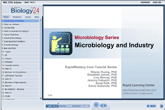| How to Learn in 24 Hours? |
|
| Need Help? |
M-F: 9am-5pm(PST):
Toll-Free: (877) RAPID-10
or 1-877-727-4310
24/7 Online Technical Support:
The Rapid Support Center
vip@rapidlearningcenter.com
Secure Online Order:

|
| Tell-A-Friend: |
Have friends taking science and math courses too? Tell them about our rapid learning system.
|
|
Microbiology and Industry
| Topic Review on "Title": |
Industrial Microbiology and the Food Industry:
- Yeast is used make breads, baked goods, alcohol, yogurt and other foods and drink items.
- Today’s yeast are specially engineered to work in large scale industrial applications.
- Specialized bacteria and molds are used to make cheeses of different types.
- Biofertilizers include bacteria such as Rhizobia that fix nitrogen.
- Food additives increase nutritional value, retard spoilage, change consistency and enhance flavor. These may be natural compounds such as guar gum and xanthan gum or flavor enhancers and vitamins.
Industrial Microbiology and Medicine:
- Biosensors are monitors used in the detection of specific targets in the environment, human body or other organisms.
- Antibiotic production is a capacity that many microbes have naturally.
- Microbes have been developed as a drug delivery system.
- Lactic acid bacteria (LAB) has been exploited to make and deliver vaccines and other bioactive materials.
- Microbes have been developed that degrade oil so that they it may be more easily extracted.
- Microbes are involved in the production of paper.
Industrial Microbiology and Economics:
- In the cosmetic industry the botulism toxin derived from Clostridium botulinum is utilized.
- Biopesticides have been developed for the control of insect, nematodes and other pathogens that effect plants.
- Synthetic energy fuels such as ethanol, methane, hydrogen and hydrocarbons are produced by microbes.
- Gasohol which is a 9:1 blend of gasoline and ethanol is a popular fuel alternative. The ethanol is produced as a by product of yeast fermentation.
- Microbes have been used in mining. An example of this is the recovery of metals is facilitated by bacteria by helping to solubilize it making it more easily extracted.
- Microorganisms have been used to clean up the environment in a process called bioremediation. In bioremediation a microbe is introduced into an environment where its natural metabolism results in the detoxification or break down of hazardous chemicals or pollutants.
Specialized Microbes:
- Rhizobia are bacteria that fix nitrogen and make it available for plant nutrition and growth. They form nodules on the roots of legumes.
- Azolla is a fee floating water plant that fixes nitrogen in association with cyanobacteria. It acts as a renewable biofertilizer.
- Azotobacter are nitrogen fixing bacteria that do not form nodules on plant roots or associate with legumes. They are free living and in addition to fixing nitrogen they can produce antibiotics and beneficial growth substances.
- Azospirillum fix nitrogen inside plant roots. They produce beneficial compounds for plant growth and can survive in wetland conditions as well as soils.
- Mycorrhiza are fungi that form symbiotic relationships with plant roots. Vesicular arbuscular mycorrhiza (VAM) is the most important member of this group. VAM colonies take up nutrients and water which is available for the plant and they act as root extensions.
Definitions:
- Probiotics are live microbes that may have a beneficial affect on a host eating them.
- Biofertilizers are living microbes that enrich the nutrient quality of soil.
- Biopesticides are microbes which are used to manage pests including insects, nematode or other organisms.
- Food additives are substances used to enhance the nutritional value, stabilize or increase the palatability of a food.
|
| Rapid Study Kit for "Title": |
| Flash Movie |
Flash Game |
Flash Card |
| Core Concept Tutorial |
Problem Solving Drill |
Review Cheat Sheet |
 |
 |
 |
|
| "Title" Tutorial Summary : |
The many roles of microorganisms in the life of humans and their environment are described. Microbes are so important that they play a role in practically every endeavor. They are involved in flood and energy production, medicine, cosmetics and even cleaning up the environment.
The use and appropriate application of microbes helps people to live better lives both biologically and economically.
|
| Tutorial Features: |
Specific Tutorial Features:
- Description of economic impact that biotechnology and microorganism make.
- Demonstrate how microorganisms are used in medicine and food industries.
- Detail the method of microorganisms in renewable energy production.
- Examples of microorganisms in bioremediation and pollution clean up are provided.
Series Features:
- Definition slides introduce terms as they are needed.
- Examples given throughout to illustrate how the concepts apply.
- A concise summary is given at the conclusion of the tutorial.
|
| "Title" Topic List: |
Microbes are critical elements in the environment to help clean up polluted areas.
Microorganisms have a role in practically every aspect of human life and industries including: medicine, manufacturing, mining, food production and others.
Microorganisms make a significant economic impact as a function of their application in industry.
|
See all 24 lessons in Anatomy and Physiology, including concept tutorials, problem drills and cheat sheets:
Teach Yourself Microbiology Visually in 24 Hours
|



